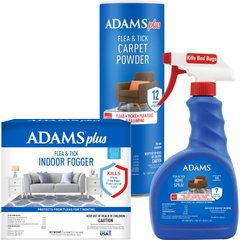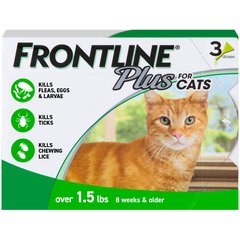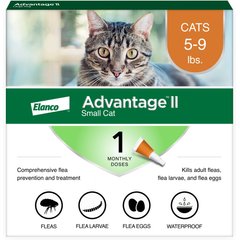5 Ways Indoor Cats Can Get Fleas
ilkermetinkursova/E+ via Getty Images
As a pet parent, you may be wondering—can inside cats get fleas? Do indoor cats need flea treatment?
While keeping cats indoors protects them from getting lost, getting into scuffles with other animals, and exposure to other harmful things, it’s still important to keep up with regular flea and tick prevention.
Fleas are tiny but powerful. They use their strong back legs to jump onto pets—and humans—as they walk by. Fleas also multiply rapidly; when feeding on a host animal, a single flea can lay up to 50 eggs a day.
Unfortunately, this can happen inside your home—not just outdoors. In fact, indoor cats can get fleas in more ways than you may think.
So, how do indoor cats get fleas?
Let’s look at everything you need to know about protecting your indoor cat from these pesky, harmful parasites.
Key Takeaways
- Indoor cats can get fleas.
- Fleas can also transmit parasites, such as tapeworms, and cat scratch fever to humans.
- The best defense against your cat getting fleas is adequate flea prevention given on a regular basis to all pets in the home.
Do Indoor Cats Get Fleas?
Indoor cats can, and regularly do, get fleas. Because pet parents may mistakenly think fleas can’t get indoors, they don’t keep their cats on flea prevention. Then, all it takes is one flea.
Females can lay up to 50 flea eggs per day, so infestations can quickly get out of control.
If indoor cats start scratching themselves or losing hair, it can be hard to believe that fleas are the cause. But even if you don’t see fleas on your cat, they could still be to blame.
Cats are very good at grooming fleas out of their fur, so they can be hard to find. And some cats—particularly those who are allergic to flea bites—can have intense reactions to just one or two bites.
How Do Indoor Cats Get Fleas?
Indoor cats may seem completely isolated from the outside world, but that is not the case. Fleas have many ways to get inside your home.
1. Other Pets in the House
The most common way for fleas to enter your household is on the family dog or another pet that comes inside from being outdoors. Cats can also get fleas from neighbor pets and local wildlife, such as:
-
Birds
-
Rabbits
-
Guinea pigs
-
Raccoons
-
Possums
-
Squirrels
-
Skunks
Even if a dog is on a monthly flea preventive, some do not repel fleas, meaning the dog can still be a temporary host for live fleas.
Flea preventives take a bit of time before they start killing parasites, so fleas can enter your house, jump off the dog, and hop onto your cat before feeling the effects of the flea medicine.
What you can do:
-
Year-round flea prevention is recommended for all cats and dogs in your home, whether they’re allowed outside or not.
-
Check your cat regularly for fleas and other insects/parasites.
-
Assure that all dogs visiting your home are up to date on their flea prevention.
2. Humans in the Home
Fleas can hang onto people and their clothing or shoes—and then ride them right into your home. While fleas do not have wings, they can jump large distances (up to 19 inches), so it’s easy for them to hop onto people.
What you can do:
-
Clean up after house guests visit—including vacuuming, washing floors, sheets, bathrooms, couches, towels, and upholstery.
-
If you suspect your cat may have been exposed to a flea-bearing guest, do a quick examination. Fleas usually camp out behind a cat’s head, along the back by the tail base, and on the underbelly.
-
Even if you don’t see fleas, you might find flea dirt, the flea’s fecal matter. If you see flea dirt, it means fleas are infesting your cat and you likely have fleas in your home.
3. Rodents
Fleas aren’t just attracted to dogs and cats; they also live and feed on many other mammals. If your house has a mouse or rat problem, they may bring fleas in too. Those fleas jump off the rodents, into your home, and onto your cat.
What you can do:
-
Keep your floors and countertops clean and free of food scraps or crumbs—stray food will attract rodents.
-
Use humane traps, metal screens over plumbing and ventilation pipes, and tight seals on your screens, windows, and doors to keep rodents from entering your home.
4. Places Your Cat Visits
Cats can pick up fleas at catteries, shelters/rescues, a vet’s office, a groomer’s, a boarding facility—any place where dogs, cats, and other animals congregate.
What you can do:
-
It’s extremely important that all cats are on veterinarian-approved and prescribed flea and tick prevention year-round.
-
If your cat has a medical history, discuss with your veterinarian which prevention would be best for their specific needs. Reading all labels on flea prevention is important to make sure you use the product correctly.
-
Never use prevention formulated for a dog on your cat and never use a prevention on your cat that is not the correct dose for their body weight. If you are unsure of your cat’s weight, take your pet to their vet for an accurate weigh-in.
5. Moving To a New Home
The excitement of moving into a new home may overshadow thoughts about what parasites might already be there. This is particularly true in condominium and apartment complexes.
Homes with carpets and central heating provide perfect conditions for year-round development of fleas.
The highest number of flea eggs, larvae, and pupae are in areas where pets spend the most time, such as on beds and furniture.
Even though fleas may be in your house, it’s not likely that they will be visible.
The eggs are tiny white specks the size of dust particles, while the larvae, which are somewhat larger, with dark heads and lighter bodies, migrate deep down in carpets, furniture, or cracks in floors, away from the light.
What you can do:
-
Have a professional cleaning service come in to clean the entire home before you move in.
-
Use a flea preventive such as a home fogger if you know the previous homeowner had pets or consider hiring a professional exterminator.
How To Get Rid of Fleas on Cats
These days, it's relatively easy to get rid of fleas safely and effectively. Flea shampoos kill adult fleas fast, but they won't stop more from showing up. Better options for cats include:
Fleas reproduce rapidly in homes and easily jump between pets. Therefore, every animal needs treatment.
Vacuum your carpets, floors and upholstery and wash bedding to get rid of flea eggs, larvae, and pupae. If more environmental control is necessary, use an indoor fogger, spray, or carpet powder.
No matter which flea control method you select, always read and follow the manufacturer’s instructions. Some chemicals in parasite treatments can be very harmful to cats.
Avoid any product that doesn't clearly state it's safe for cats.
How To Prevent Fleas on Cats
The best defense against your cat getting fleas is adequate flea prevention given on a regular basis to all pets in the home.
Many preventions require a prescription from your veterinarian, who can also help you determine the best flea and tick preventative medication for your cat depending on their lifestyle, age, and weight.
Fleas can be a big problem for cats, even for those who stay indoors.
Some cats can have an allergic reaction, which worsens the itching and discomfort. Fleas can especially pose an immediate danger to kittens, as an infestation can cause anemia and even death.
Fleas can also transmit parasites, such as tapeworms, and cat scratch fever to humans.
Checking for fleas and taking measures to prevent them are important habits to help ensure the health of your cat and your family.





